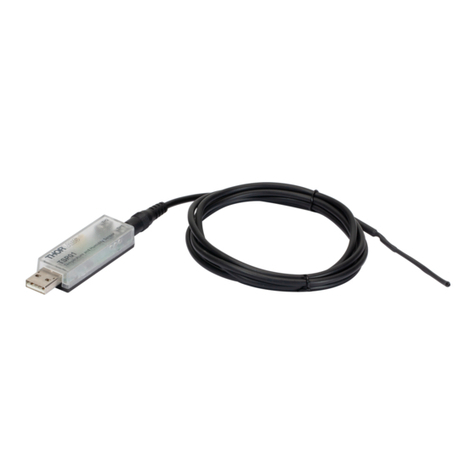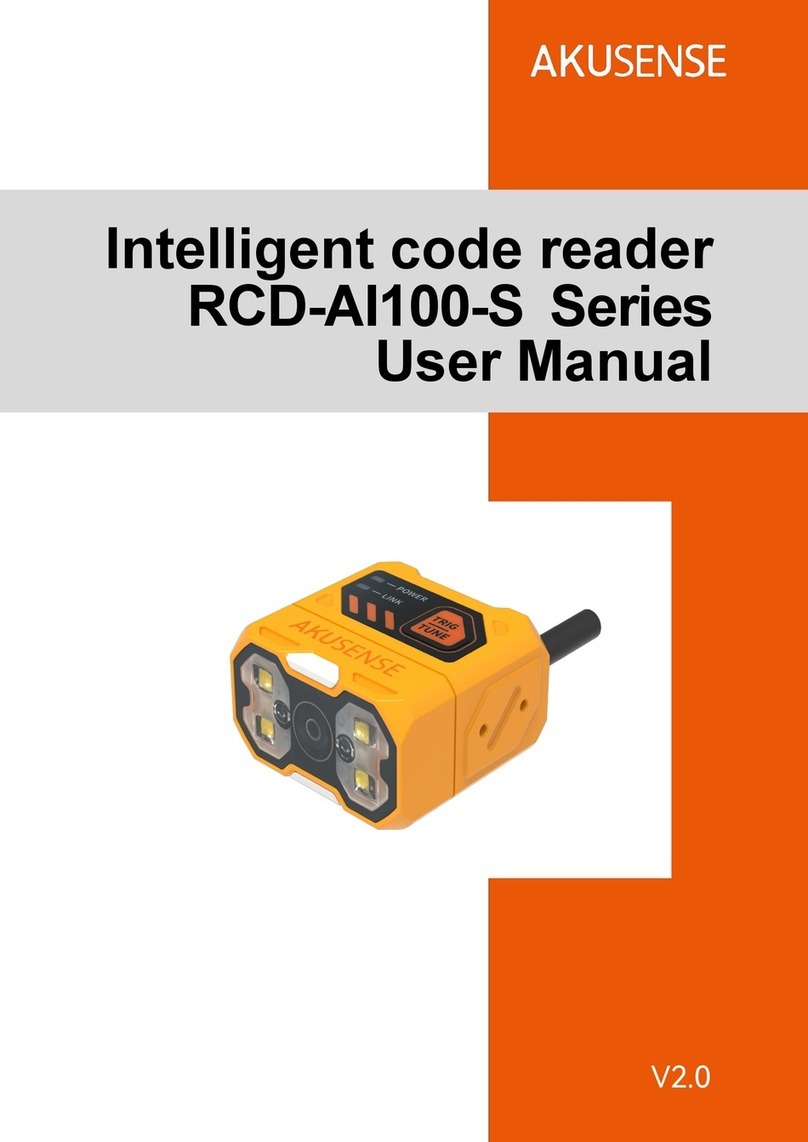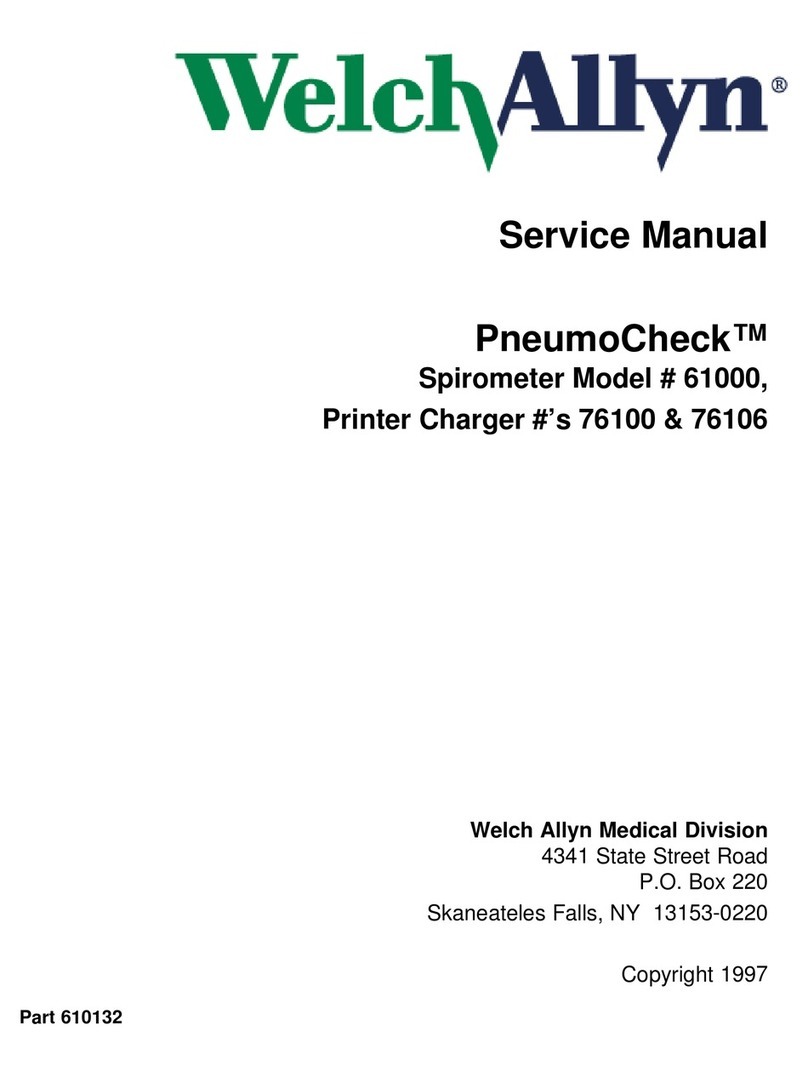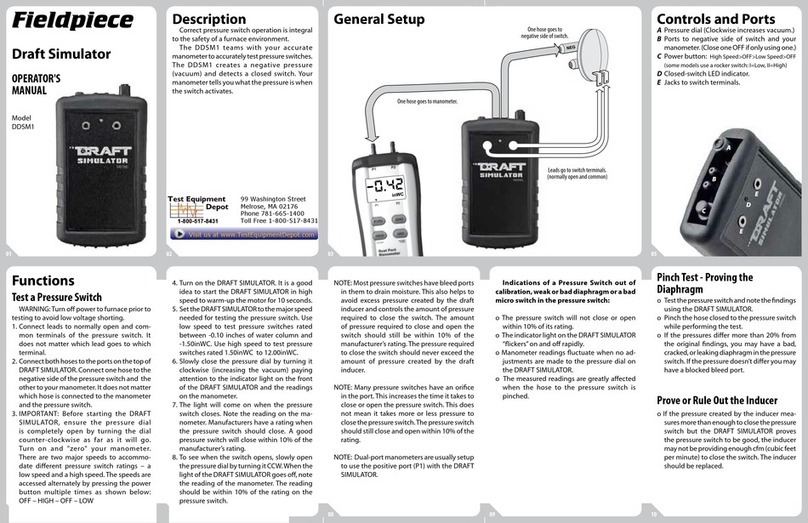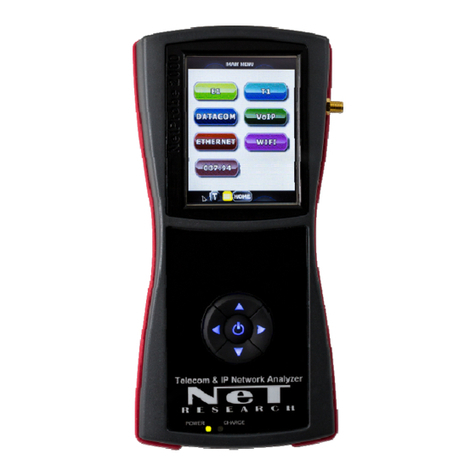BRANNSTROM CleanTrack 1000 B User manual

Brannstrom Sweden AB
Uddevallagatan 14
416 70 Gothenburg, Sweden
Tel: +46 (0)31 195600
Fax: +46 (0)31 197790
Operations and Technical manual for
Oil Discharge Monitoring Equipment
CleanTrack 1000 B
(Software version 2.12)

Brannstrom Sweden AB CleanTrack 1000B - Rev 2.12, 2015 Page 2of 222
Content
1. Introduction..........................................................................................................................................5
2. Important Notes...................................................................................................................................5
2.1. Component Replacement/Repair .......................................................................................................... 5
2.2. Disclaimer and Conditions ................................................................................................................... 5
3. Specification..........................................................................................................................................6
3.1. Description ........................................................................................................................................... 6
3.2. Measuring principle.............................................................................................................................. 6
3.3. Scope of Supply and System Supplies.................................................................................................. 6
4. Installation............................................................................................................................................10
4.1. Computer Unit...................................................................................................................................... 10
4.1.1. Mechanical......................................................................................................................... 10
4.1.2. Electrical............................................................................................................................ 10
4.2. Converting Unit.................................................................................................................................... 11
4.2.1. Mechanical......................................................................................................................... 11
4.2.2. Electrical............................................................................................................................ 11
4.3. Analyzing Unit ..................................................................................................................................... 12
4.3.1. General drawings ............................................................................................................... 12
4.3.2. Mechanical......................................................................................................................... 12
4.3.3. Electrical............................................................................................................................ 12
4.3.4. Inlet probe and Outlet stub................................................................................................. 13
4.3.5. Piping of Sample Inlet and Outlet...................................................................................... 14
4.3.6. Piping for Fresh water (Option)......................................................................................... 14
4.3.7. Piping for Air motor (Air motor option only) .................................................................... 15
4.4. Flow meter and Speed log .................................................................................................................... 16
4.4.1. Flow meter general ............................................................................................................ 16
4.4.2. BRANNSTROM standard flow transmitter....................................................................... 16
4.4.3. Speed log general............................................................................................................... 16
4.5. Paper Printer ......................................................................................................................................... 17
4.6. Response time calculations................................................................................................................... 17
4.7. First Start up Checklist ......................................................................................................................... 18
4.8. Pressure alarm settings ......................................................................................................................... 19
4.9. Zener Barrier Instructions and Replacement ........................................................................................ 20
4.10. Measuring Cell Instructions and Replacement ................................................................................... 25
4.10.1. Measuring Cell replacement (CTB10032) ....................................................................... 28
4.11. Calculations on intrinsically safe arrangements.................................................................................. 31
5. Start/Stop procedure............................................................................................................................33
5.1. Start-up procedure ................................................................................................................................ 33
5.2. Close down procedure .......................................................................................................................... 34
6. Menu operations...................................................................................................................................35
6.1. Main Menu and Top of Page indications.............................................................................................. 35
6.2. Edit Numeric values ............................................................................................................................. 36
6.3. Keys...................................................................................................................................................... 36
6.4. Password............................................................................................................................................... 37
6.5. Measuring Cell - Indications and Keys................................................................................................. 38
7. Menu layout..........................................................................................................................................39
7.1. Main Menu ........................................................................................................................................... 39
7.2. Operation.............................................................................................................................................. 40
7.2.1. Running ............................................................................................................................. 40
7.2.2. Running Settings................................................................................................................ 41
7.2.2.1. "Discharge line" 41
7.2.2.2. "Oil type" 42
7.2.3. Manual Override................................................................................................................ 44
7.2.4. Status ................................................................................................................................. 45
7.3. Alarm Table.......................................................................................................................................... 46
7.4. Recorded data ....................................................................................................................................... 47
7.5. USB ...................................................................................................................................................... 48
7.5.1. USB-Memory stick............................................................................................................ 48
7.5.2. Save Printouts on USB stick .............................................................................................. 50
7.6. On-board Test....................................................................................................................................... 51
7.7. Measuring Cell Check/Calibration ....................................................................................................... 55
7.7.1. Zero Calibration Status ...................................................................................................... 55
7.7.2. Zero Calibration Prepare.................................................................................................... 56
7.7.3. Zero Calibration Take Zero ............................................................................................... 57
7.7.4. Replace Measuring Cell..................................................................................................... 58
7.8. Setup of parameters .............................................................................................................................. 59
7.8.1. Line of discharge ............................................................................................................... 59
7.8.2. ZF1 (Zener barrier flow input 1)........................................................................................ 60
7.8.3. ZF2 .................................................................................................................................... 60
7.8.4. CVF ................................................................................................................................... 60

Brannstrom Sweden AB CleanTrack 1000B - Rev 2.12, 2015 Page 3of 222
7.8.5. Pressure.............................................................................................................................. 61
7.8.6. Speed ................................................................................................................................. 61
7.8.7. System Configuration Setup .............................................................................................. 62
7.9. Computer.............................................................................................................................................. 63
7.9.1. USB-Memory stick............................................................................................................ 63
7.9.2. Real Time Clock................................................................................................................ 63
7.9.3. IP-address .......................................................................................................................... 64
7.9.4. Touch Screen ..................................................................................................................... 64
7.10. System Check ..................................................................................................................................... 65
7.10.1. Main................................................................................................................................. 65
7.10.2. Test .................................................................................................................................. 65
7.10.3. GPS (NMEA-receiver) .................................................................................................... 66
7.10.4. Paper Printer _(Optional)................................................................................................. 66
7.10.5. Expiry (Trial period)...................................................................................................... 67
7.10.6. Power (Computer unit Power supply)............................................................................ 67
7.10.7. CUIO (Computer unit I/O PCB) .................................................................................... 68
7.10.8. CVCT (Converting unit I/O PCB) ................................................................................. 68
7.10.9. ZBCT (Converting unit Zener Barrier PCB).................................................................. 69
7.10.10. MC (Measuring Cell)..................................................................................................... 69
7.11. Approvals ........................................................................................................................................... 70
8. Fault-finding.........................................................................................................................................71
8.1. List of displayed alarms........................................................................................................................ 71
8.2. System file errors.................................................................................................................................. 72
8.3. System communications errors............................................................................................................. 72
8.4. External sensor alarms.......................................................................................................................... 73
8.5. Measurement alarms............................................................................................................................. 74
8.6. Measurement sample alarms................................................................................................................. 74
8.7. Paper Printer alarms ............................................................................................................................. 75
8.8. Indications on PCB's............................................................................................................................. 76
8.8.1. Computer unit I/O PCB indications ................................................................................... 76
8.8.2. Converting unit I/O PCB indications ................................................................................. 77
8.8.3. Zener barrier PCB indications ........................................................................................... 77
9. Maintenance, Spare parts and Consumables.....................................................................................78
9.1. Battery replacement.............................................................................................................................. 78
9.2. Saving Printouts and Settings on a USB memory stick ........................................................................ 78
9.3. Periodic Checks and Servicing ............................................................................................................. 78
9.4. Verification of accuracy and access to restricted parts. ........................................................................ 78
9.5. Cleaning of Inlet Filter ......................................................................................................................... 79
9.6. Sample Pump Shaft seal oil refilling .................................................................................................... 79
9.7. Spare parts ............................................................................................................................................ 79
9.7.1. Computer Unit ................................................................................................................... 79
9.7.2. Converting Unit ................................................................................................................. 79
9.7.3. Analyzing Unit................................................................................................................... 79
9.8. Recommended Spare parts ................................................................................................................... 79
9.9. Consumables ........................................................................................................................................ 79
9.10. Storage before installation .................................................................................................................. 80
10. Figures and Drawings........................................................................................................................81
10.1. Computer Unit.................................................................................................................................... 82
10.2. Converting Unit.................................................................................................................................. 85
10.3. Analyzing Unit ................................................................................................................................... 88
10.3.1. Analyzing Unit skid with Ex. motor Sample pump ......................................................... 88
10.3.2. Analyzing Unit with external Sample pump .................................................................... 91
10.3.3. Analyzing Unit with Freestanding items for External Sample pump............................... 96
10.3.4. Analyzing Unit with Air motor Sample pump ................................................................. 97
10.4. Nikuni Bulkhead Sample pump.......................................................................................................... 102
10.5. Connection box................................................................................................................................... 105
10.6. Measuring Cell replacement ............................................................................................................... 107
10.7. GA-plans ............................................................................................................................................ 108
10.7.1. Partnames of typical arrangement.................................................................................... 108
10.7.2. GA-plan with skid Ex. motor Sample pump .................................................................... 109
10.7.3. GA-plan with bulkhead penetrating Sample pump .......................................................... 111
10.7.4. GA-plan with Air motor Sample pump............................................................................ 113
10.7.5. GA-plan with pilot controlled Air motor Sample pump .................................................. 115
10.8. Electrical............................................................................................................................................. 116
10.8.1. Electrical cable diagram for electrical Ex. motor sample pump....................................... 116
10.8.2. Electrical cable diagram for bulkhead mounted sample pump......................................... 117
10.8.3. Electrical cable diagram for air motor sample pump ....................................................... 118
10.9. Sample probes .................................................................................................................................... 119
10.9.1. Sample probes installation arrangements ½” ................................................................... 119
10.9.2. Sample probes installation arrangements 1” .................................................................... 120
10.10. Flow meter........................................................................................................................................ 122
11. Approval Certificates.........................................................................................................................125

Brannstrom Sweden AB CleanTrack 1000B - Rev 2.12, 2015 Page 4of 222
11.1. IMO Certificate .................................................................................................................................. 125
11.2. Type Approval, DNV: MED-B .......................................................................................................... 126
11.3. Certificate: MED-D ............................................................................................................................ 129
11.4. IMO Certificate, CCS ......................................................................................................................... 130
11.5. Type Approval, CCS .......................................................................................................................... 131
11.6. Type Approval, NK ............................................................................................................................ 134
11.7. Type Approval, RMRS....................................................................................................................... 135
11.8. Declaration of Conformity.................................................................................................................. 137
12. ATEX Certificates and Instructions.................................................................................................140
12.1. ATEX Certificate Zener Barrier PCB................................................................................................. 140
12.2. ATEX Certificate Measuring Cell ...................................................................................................... 145
12.3. Pressure transmitter, Danfoss ............................................................................................................. 149
12.4. Pressure transmitter, Siemens............................................................................................................. 156
12.5. Pressure transmitter, Tecsis ................................................................................................................ 159
12.6. Flow meter, Siemens .......................................................................................................................... 163
12.7. Flow meter, Fuji ................................................................................................................................. 171
12.8. Sample Pump, SPP-100 with Elprom explosion proof motor............................................................. 173
12.8.1. Elprom instructions.......................................................................................................... 173
12.8.2. Elprom Certificate............................................................................................................ 177
12.9. Sample Pump, Speck pump with Gast air motor ................................................................................ 194
13. Appendix, Work shop test and Calibration Certificate..................................................................221
14. Project specific drawings and data sheet .........................................................................................222

Brannstrom Sweden AB CleanTrack 1000B - Rev 2.12, 2015 Page 5of 222
1. Introduction
The Oil Discharge Monitoring System, Cleantrack 1000 B, has been designed to provide means of
monitoring, recording and controlling the ballast discharge in accordance with the requirements in
Resolution MEPC.108(49) as amended by Resolution MEPC.240(65) and is also approved for Bio-
fuel blends in accordance with MEPC.1/Circ.761 as revised.
The requirements of the MARPOL Convention are that all oil tankers with a gross tonnage of 150
GRT and above must have an oil discharge monitoring and control system installed with an
automatic overboard valve control system.
The requirements in Resolution MEPC.108(49) as amended apply to tankers with a date of keel
laying or equivalent stage of construction of 1st of January 2005 or later. Tankers with a keel laid
before 1st of January 2005 should comply either with these new or the older Guidelines and
Specifications.
Discharge limits are set at 30 liters per nautical mile and a total discharge expressed as a proportion
of the previous cargo for dirty ballast. The unit has also a 15 ppm mode intended for clean ballast.
The recording device is formatted electronically as mentioned in MEPC.108(49) chapter 6.9.1.
Recorded data is stored in a non-volatile memory and can hold approximately 4.000.000 printouts.
Optionally a paper printer can also be installed in the computer unit.
Normally a ship specific manual is developed, covering the complete, ship specific system as
installed on board, in order to identify and have a better access to the system.
2. Important Notes
2.1. Component Replacement/Repair
Placement of security seals on critical components is to prevent tampering by unauthorized
personnel. Replacement or repair of this equipment should only be carried out under guidance of
Brannstrom Sweden AB.
2.2. Disclaimer and Conditions
All information provided by Brannstrom Sweden AB about this equipment is given in good faith
and is based on the best knowledge available at the particular time. No responsibility is, however,
assumed for possible inaccuracies or omissions.
The content of this manual may be copied as required for operational use on the vessel in which the
equipment is installed. This Manual must not be copied, in full or in part, for disclosure to third
part.
The software incorporated in the equipment is furnished on a strictly “as is” basis. The software is
proprietary to Brannstrom Sweden AB. The disclosure of the software coding is not allowed. The
software may not be copied in whole or part.

Brannstrom Sweden AB CleanTrack 1000B - Rev 2.12, 2015 Page 6of 222
3. Specification
3.1. Description
Type CleanTrack 1000 B
Application Crude and Petroleum products in accordance with MEPC.108(49) as
amended by Resolution MEPC.240(65) and also approved for
Bio-fuel blends in accordance with MEPC.1/Circ.761 as revised.
Range 0 - 1000 ppm
Accuracy According to MEPC.108(49)
Calibration Oil Type 1-9 for Crude and Petroleum products.
5 types for Bio-fuel blends.
Sample Flow rate Depending on Sample Pump.
240 liters/hour to 900 liters/hour.
Optional Clean water:
Clean water Flow rate Depending on Sample Pump and Water pressure.
Intermittently 200 to 600 liters/hour.
Clean water is only used at Discharge Start and Stop.
Approximately 6-20 liters per Start/Stop.
Clean water Pressure, option max. 5 bar
min. 0.5 bar higher than the pressure in the overboard line at the
sample outlet connected point.
3.2. Measuring principle
The measuring principle of the CleanTrack 1000B is based on a combination of light transmitted
and light scattering in four different angles. The sample water stream is homogenized in the sample
feed pump and is passed through a quartz glass tube where it is exposed to a light beam. The light
transmitted and scattered in the selected angles is dependent on the type and amount of
contaminates in the water stream. Signals from non-oil contaminants can be compensated for due to
their different light scattering characteristics.
There is a pressure transmitter connected to the output of the sample feed pump that is used to
measure and protect the ODME from pump blockages or starvation.
3.3. Scope of Supply and System Supplies
The Cleantrack 1000B parts:
1. Computer unit, 1 pcs.
2. Converting unit, 1 pcs.
a. Electric motor sample pump.
b. Air motor sample pump.

Brannstrom Sweden AB CleanTrack 1000B - Rev 2.12, 2015 Page 7of 222
3. Analyzing unit, 1 pcs.
a. Skid for sample pump with explosion proof electric motor.
b. External sample pump.
1. Cabinet.
2. Freestanding items with measuring cell hood.
c. Internal sample pump with air motor.
4. Sample pump, 1pcs
a. Explosion proof electric motor, normally mounted on skid in pump room.
b. Electric motor mounted on bulkhead, engine room/pump room.
c. Air motor, normally mounted inside analyzing unit.
5. Flow meter(s) – Optional.
6. Sample probes including valves and inlet filter – Optional.
7. Overboard valve and Slop tank valve – Optional.
8. Pneumatic control box for Overboard and Slop tank valves – Optional.
9. Miscellaneous.
1. Computer unit:
Voltage 85-265 VAC
Frequency 50/60 Hz
Consumption 30 Watt
Protection IP40
Ambient Temp. 5 - 50 °C
Weight ~7 kg
Dimensions approx. 370 x 210 mm
2. Converting unit:
2.a. Electric Motor Sample Pump:
Voltage 380 or 440 VAC 3-phase (door not displayed)
±10%, transient ±20%
Frequency 50/60 Hz
Consumption 120 Watt (exclusive pump)
Protection IP54
Ambient Temp. 5 - 50 °C
Weight ~14 kg
Tolerance MEPC.108(49)
Dimensions approx. 550 x 360 x 130 mm
Color RAL-7035
Motor protection relay Suitable for sample pump motor current.
Or:
2.b. Air Motor Sample Pump: (door not displayed)
Voltage 110 or 220 VAC
±10%, transient ±20%
Frequency 50/60 Hz
Consumption 120 Watt
Protection IP54
Ambient Temp. 5 - 50 °C
Weight ~14 kg
Tolerance MEPC.108(49)
Dimensions approx. 550 x 360 x 130 mm
Color RAL-7035

Brannstrom Sweden AB CleanTrack 1000B - Rev 2.12, 2015 Page 8of 222
3. Analyzing unit:
3.a. Skid for Sample Pump with Ex. Proof Electric Motor:
(Voltage is supplied via converting unit)
Voltage 380 or 440 VAC 3-phase
Frequency 50/60 Hz
Consumption 0.66 kWatt
Sample flow 600 l/h (nominal)
Sample Temp. 0 - 65 ºC
Ambient Temp. -20 - +55 ºC
Weight ~35 kg
Dimensions approx. 350 x 410 x 250 mm
Or:
3.b. External Sample Pump: (door not displayed)
3.b.1. Cabinet:
Sample flow 240-900 l/h (depending on sample pump)
Sample Temp. 0 - 65 ºC
Weight ~10 kg
Protection: IP56
Ambient Temp. -25 - +55 ºC *
Dimensions approx. 350 x 410 x 250 mm
or:
3.b.2. Freestanding items with measuring cell hood:
(Intended for retrofit installation inside an existing cabinet)
Sample flow 240-900 l/h (depending on sample pump)
Sample Temp. 0 - 65 ºC
Or:
3.c. Internal Sample Pump with Air Motor: (door not displayed)
Air pressure 5.2 bar
Air consumption ~30 m3/h
Sample flow 240 l/h (nominal)
Sample Temp. 0 - 65 ºC
Weight ~18 kg
Protection: IP56
Ambient Temp. +1 - +40 ºC *
Dimensions approx. 350 x 410 x 250 mm
4.b. Bulkhead mounted Sample Pump (Nikuni):
Sample flow 900 l/h
Weight ~52 kg
* If sample temperature is higher than the ambient temperature limit the limit becomes lower or cabinet should be ventilated.

Brannstrom Sweden AB CleanTrack 1000B - Rev 2.12, 2015 Page 9of 222
Parts always included in the Analyzing unit:
Measuring Cell (including its mounts):
Design Pressure 10 bar
Protection IP56
Ambient Temp. -25 - +55 ºC
Sample Temp. 0 - 65 ºC
Orifice on outlet Ø 2.5, 3.5 or 4.3 mm
Connection Box, (for intrinsically safe circuits only):
Protection IP56
Ambient Temp. -25 - +55 ºC
Pressure transmitter:
Intrinsically safety must comply with the particular hazardous area
Type 4-20mA, (2-wire 24VDC loop powered)
Protection IP class required for the particular area.
Ambient Temp. -25 - +55 ºC
Sample Temp. min. 0 - 65 ºC
Measuring range 0-16 bar (any range 0-10 bar to 0-25 bar can be used)

Brannstrom Sweden AB CleanTrack 1000B - Rev 2.12, 2015 Page 10 of 222
4. Installation
This chapter contains advice for the installation of CleanTrack 1000 B equipment on board tankers. The advice given in
this chapter is of general validity and should be supplemented with a detailed installation specification for the particular
ship. Additionally all applicable regulations regarding the installation standard, issued by the relevant authorities and
classification society must be followed.
For instance, if CENELEC applies, compliance is required with EN 60079-14 and EN 60079-17.
4.1. Computer Unit
4.1.1. Mechanical
Refer to drawings/chapters:
CTB10030 sheet 1, chapter 10.1. Computer Unit page.82 Both wall and panel mount options are shown.
P3715090 sheet 1, Computer Unit panel mount instructions page 84.
The Computer Unit is installed in the cargo control room or an equivalent dry and safe space.
4.1.2. Electrical
Refer to one of the drawings below:
CTB110204.1el, chapter 10.8.1. Electrical cable diagram for electrical Ex. motor sample pump page 116.
CTB110204.1bh, chapter 10.8.2. Electrical cable diagram for bulkhead mounted sample pump page 117.
CTB110204.1pn, chapter 10.8.3. Electrical cable diagram for air motor sample pump page 118.
Supply voltage should be single phase 115/230VAC, 50-60Hz.
(Computer unit work on voltages 85 - 265VAC).
Power consumption 30VA.
The power should be equipped with a main switch, or if specified, a detachable connector.
The fuse size should be 6A.
The alarm relay is normally open. An activated alarm is indicated with an open relay, which means that the alarm is
activated when the power supply fails.
Data communication between Computer Unit and Converting Unit, Cb5:
Type: RS485
Baudrate: 19200 baud.
Length: ≤1200 meters. (Might be shorter depending on cable used, see RS485 standards.)

Brannstrom Sweden AB CleanTrack 1000B - Rev 2.12, 2015 Page 11 of 222
4.2. Converting Unit
4.2.1. Mechanical
Refer to drawing:
CTB10003 sheet 1, chapter 10.2. Converting Unit page 85.
The Converting Unit should be mounted vertically in a safe (non-hazardous) area, normally in the engine room, as close
as possible to the Analyzing Unit at the other side of the bulkhead. The unit should be provided with enough space to
open the cabinet door.
4.2.2. Electrical
Refer to drawings:
CTB10003 sheet 2 of 3, Converting Unit page.86.
CTB10003 sheet 3 of 3, Converting Unit page 87.
oItem d7 = equipotential rail, in the text below.
oItem d8 = PE rail, in the text below.
For electrical explosion proof motor sample pump:
CTB10907 sheet 1 of 1, GA-plan with skid Ex. motor sample pump page 109.
CTB10917 sheet 1 of 1, GA-plan with skid Ex. motor sample pump and flushing page 110.
CTB110204.1el, electrical cable diagram for electrical Ex. motor sample pump page 116.
For electrical bulkhead penetration sample pump:
CTB10906 sheet 1 of 1, GA-plan with bulkhead penetrating Sample pump page 111.
CTB10916 sheet 1 of 1, GA-plan with bulkhead penetrating Sample pump and flushing page 112.
CTB110204.1bh, electrical cable diagram for bulkhead mounted sample pump page 117.
For air motor sample pump:
CTB10901 sheet 1 of 1, GA-plan with air motor sample pump page 113.
CTB10911 sheet 1 of 1, GA-plan with air motor Sample pump and flushing page 114.
CTB10903 sheet 1 of 1, GA-plan with pilot controlled air motor sample pump page 115.
CTB110204.1pn, electrical cable diagram for air motor sample pump page 118.
Refer also to the document “INSTRUCTIONS Oil Monitor interface type Z11”
Chapter 4.8. Zener Barrier Instructions and Replacement page 20.
The power supply should be equipped with a main switch, or if specified, a detachable connector. Fuse size should be 3
x 10A for Converting Units equipped to supply electrical motor sample pumps and 6A fuse for air motor sample pumps.
Check that the supply voltage corresponds to the voltage specified on the label below the mains terminals.
A 3-pole isolator switch can be installed in the safe area on Cb2 to being able to detach the sample pump while keeping
power to the converting unit. This can be useful if a zener barrier input is used for the overboard valve feedback.
Shields of cables for intrinsically safe equipment in both hazardous and non-hazardous area should normally be
electrically connected to earth at one point only, normally in the non-hazardous area end of the circuit loop. This
requirement is to avoid the possibility of the screen carrying a possibly incentive level of circulating current in the event
that there are local differences in earth potential between one end of the circuit and the other.
All shields of Cb7 and other cables for intrinsically safe equipment connected to the Zener Barrier PCB should
be connected to earth. This is made via the equipotential rail (see CT10003 sheet 3 page 87, item d7) located
below the Zener Barrier PCB at the right side in the Converting Unit. The rail is from factory connected to the
PE rail (see CT10003 sheet 3 page 87, item d8) located at the low left side in the Converting Unit. The PE rail
shall be connected to ground/earth (and the equipotential rail is then also connected to ground/earth).
If another earthing system is preferred for the cable shields of the intrinsically safe equipment the equipotential rail
should be disconnected from the PE rail and instead connected to the preferred earthing system.
Connections must satisfy the requirements of the relevant classification society.
Keep Cb7 and other cables connected to intrinsically safe circuits separated from non-intrinsically safe circuit cables.
Data communication between Converting Unit and Analyzing Unit, Cb7:
Baudrate: 19200 baud.
Length: ≤50 meters.

Brannstrom Sweden AB CleanTrack 1000B - Rev 2.12, 2015 Page 12 of 222
4.3. Analyzing Unit
4.3.1. General drawings
For item numbers and piping of a typical arrangement refer to drawing:
CTB10601 sheet 1 of 1, Partnames of typical arrangement page 108.
The Analyzing Unit/Measuring Cell should be mounted vertically and lower than the sample outlet probe, to safeguard
a positive pressure in the sample water system at all times.
For draining possibilities of the sample piping arrangement the drain valve, item 42, should be the lowest point.
A separate draining possibility for the pump head of the sample pump is needed for some pump types.
4.3.2. Mechanical
For skid mounted electrical Ex. motor sample pump refer to drawings/chapters:
Chapter 10.3.1. Analyzing Unit skid with Ex. motor Sample pump page 88.
For electrical bulkhead penetration sample pump refer to drawings/chapters:
Chapter 10.3.2. Analyzing Unit with external Sample pump page 91.
Chapter 10.4. Nikuni Bulkhead Sample pump page 102.
For air motor sample pump refer to drawings/chapters:
Chapter 10.3.4. Analyzing Unit with Air motor Sample pump page 97.
For retrofitting inside existing analyzing cabinet
Chapter 10.3.3. Analyzing Unit with Freestanding items for External Sample pump page 96.
Chapter 10.5. Connection box page 105.
The Analyzing Unit should be mounted in the pump room with 4 bolts welded clips on the pump room to engine room
bulkhead as close as possible to the Converting Unit at the other side of the bulkhead or in an equivalent suitable
location. The unit should be provided with enough space to open the cabinet door and enough space to facilitate
cleaning of the Measuring Cell from above with a brush. There should also be space for operating the valve handles and
taking grab samples.
The Analysing Unit should be mounted lower than the sample outlet probe, to safeguard a positive pressure in the
sample water system at all times.
Any valves having coated aluminum levers should be protected from falling objects.
4.3.3. Electrical
For skid mounted electrical Ex. motor sample pump refer to drawings/chapters:
Chapter 12.8.1. Elprom instructions page 173
CTB110204.1el, electrical cable diagram for electrical Ex. motor sample pump page 116
Chapter 10.3.1. Analyzing Unit skid with Ex. motor Sample pump page 88.
Chapter 10.5. Connection box page 105
For electrical bulkhead penetration sample pump refer to drawings/chapters:
CTB110204.1bh, electrical cable diagram for bulkhead mounted sample pump page 117.
Chapter 10.3.2. Analyzing Unit with external Sample pump page 91
Chapter 10.5. Connection box page 105
For air motor sample pump refer to drawings/chapters:
CTB110204.1pn, electrical cable diagram for air motor sample pump page 118.
CTB10010 sheet 3 of 5, Analyzing unit with air motor sample pump page 99.
CTB10010 sheet 5 of 5, Analyzing unit with air motor sample pump page 101.
Chapter 10.5. Connection box page 105
For retrofitting inside existing analyzing cabinet.
Mount a freestanding measuring cell mounted with its hood and a connection box on the backplane.
Refer to drawings/chapters:
Use cable diagram above for the actual sample pump used.

Brannstrom Sweden AB CleanTrack 1000B - Rev 2.12, 2015 Page 13 of 222
CTB10601 sheet 1 of 1, Partnames of typical arrangement page 108.
10.3.3. Analyzing Unit with Freestanding items for External Sample pump page 96.
Chapter 10.5. Connection box page 105
Refer also to the document “INSTRUCTIONS Measuring cell type CTB11”
Chapter 4.9. Measuring Cell Instructions and Replacement page 25 that also contains the drawings
CTB10032, CTB10033 sheet 1 and CTB11036.
Check the Sample pump, the Measuring Cell and the Pressure transmitter documentation concerning intrinsically safety
and that the equipment complies with the installation regulations for this particular hazardous area.
Connect Cb7, Cb3 and Cb3a to the Connection box. Terminate the Cables according to the electrical cable diagram for
the actual sample pump used.
Shields of Cb7, Cb3 and Cb3a should all normally be connected to the equipotential rail in the Connection Box
of the Analyzing Unit. The equipotential rail shall NOT be connected to earth.
Cables Cb3 and Cb3a can also be directly wired from the flow meter to the Converting Unit without connections via the
Connection box.
Make sure the Analyzing Unit and the Connection box is properly connected to earth according to the applicable
regulations for this particular hazardous area.
If an electrical Ex Sample pump is used:
If a thinner cable, Cb2 is used than given in drawing CTB10015 sheet 2 of 3, Analyzing unit skid with electrical Ex.
motor sample pump page 89 size down with a cable gland approved for the actual hazardous area and the pump
temperature.
Make sure the frame of the explosion proof motor is properly connected to earth according to the applicable regulations
for this particular hazardous area.
(It should normally be connected to earth with a cable (earth conductor) having a section area of minimum 4 mm².)
4.3.4. Inlet probe and Outlet stub
For basic convention requirements, see Resolution MEPC.108(49) chapter 6.3.
Refer to drawings in chapter 10.9. Sample probes page 119.
The inlet probe is mounted upstream of the outlet stub and the flow meter sensor should preferably be mounted between
the inlet probe and the outlet stub. A positive water pressure must be available in the discharge line under all discharge
conditions at the place where the inlet probe is located. The outlet probe shall be located higher than the analyzing unit
outlet connection. The sample feed pump may be damaged if run dry for more than 10 seconds.
The sample valves and sample inlet filter should be located with adequate space and accessibility for servicing.

Brannstrom Sweden AB CleanTrack 1000B - Rev 2.12, 2015 Page 14 of 222
4.3.5. Piping of Sample Inlet and Outlet
Pipes: Tb11 and Tb13
For skid mounted electrical Ex. motor sample pump refer to drawings/chapters:
Chapter 10.7.2. GA-plan with skid Ex. motor Sample pump page 109.
Chapter 10.3.1. Analyzing Unit skid with Ex. motor Sample pump page 88.
Recommended pipe dimensions for SPP-100 pump:
Pipe diameter 15x1 mm
Recommended maximum pipe length 10 m
According to response time calculations, maximum pipe length of Tb13 is 30 m. When using a long Tb13 pipe
it is important to consider the pressure drop in Tb13, please see point 1. below in this chapter.
For electrical bulkhead penetration sample pump refer to drawings/chapters:
Chapter 10.7.3. GA-plan with bulkhead penetrating Sample pump page 111.
Chapter 10.3.2. Analyzing Unit with external Sample pump page 91.
Chapter 10.4. Nikuni Bulkhead Sample pump page 102.
Recommended pipe dimensions for Nikuni pump:
Pipe diameter 22x1 mm
Maximum pipe length 25 m
For air motor sample pump refer to drawings/chapters:
Chapter 10.7.4. GA-plan with Air motor Sample pump page 113.
Chapter 10.7.5. GA-plan with pilot controlled Air motor Sample pump page 115.
Chapter 10.3.4. Analyzing Unit with Air motor Sample pump page 97.
Recommended pipe dimensions for air motor pump:
Pipe diameter 15x1 mm
Maximum pipe length 12 m
Other pipe dimensions than recommended above may be used but the 3 points below must be met at all time:
1. A positive pressure must be secured in Tb13 to avoid starvation of the sample pump. Relevant pressure drop
calculations should be made.
2. The Drain Valve should be the lowest point of the inlet and outlet piping for efficient draining to avoid freezing
damages.
3. The sample transmit time should be recalculated to each installation to make sure that the requirements
regarding total system response time is satisfied. See chapter 4.6. Response time calculations page 17.
The sample valves and sample inlet filter should be located with space for accessibility and servicing.
4.3.6. Piping for Fresh water (Option)
Pipe: Tb8
For skid mounted electrical Ex. motor sample pump refer to drawing:
CTB10917 sheet 1 of 1, GA-plan with skid Ex. motor sample pump and flushing page 110.
For electrical bulkhead penetration sample pump refer to drawing:
CTB10916 sheet 1 of 1, GA-plan with bulkhead penetrating Sample pump and flushing page 112.
For air motor sample pump refer to drawing:
CTB10911 sheet 1 of 1, GA-plan with air motor Sample pump and flushing page 114.
The pipe should be provided with a shut of valve close to the bulkhead penetration.
Bulkhead penetrations must satisfy the requirements of the relevant classification society.
The fresh water supply should be provided with one shut off and one vacuum check valve and one check valve. The
fresh water temperature should not be lower than the sample water temperature. Suitable temperature is about 0º - 10º
Celsius warmer than the sample water temperature. The water should, however, not be warmer than 65º Celsius.
The water consumption is about 250 l/h and is open about 30 seconds at start-up. It is also recommended to flush
manually at closing down. This makes about 10-15 liters per start/stop.

Brannstrom Sweden AB CleanTrack 1000B - Rev 2.12, 2015 Page 15 of 222
The water pressure should not be higher than 5 bar and not less than 0.5 bar higher than the overboard line pressure at
the sample outlet connection point.
4.3.7. Piping for Air motor (Air motor option only)
Pipe: Tb20
Refer to drawings/chapters:
CTB10601 sheet 1 of 1, Partnames of typical arrangement page 108.
10.3.4. Analyzing Unit with Air motor Sample pump page 97.
The supplied air should be clean and dry. The pressure is displayed on a pressure gauge inside the Analyzing Unit.
It is recommended to install a pressure regulator, a water trap and a filter.
Air pressure at the pump 5.2 bar
Air consumption, about 30 nm3/h
Below table can be used as a guidance only for minimum pipe diameter for a given pipe length and a minimum initial
pressure. The calculation is for a straight pipe, pressure drops at bends has not been taken in account. Make own
calculations and have margin to allow the pressure regulator to work properly.
Pressure(final) = 5.2 bar (pipe inner diameter, [mm])
Pipe length, [m]
100 17 15 14 14 13 13 12 12 12 11 11 11 11 10 10 10 10 10
95 16 15 14 13 13 12 12 12 11 11 11 11 11 10 10 10 10 10
90 16 15 14 13 13 12 12 12 11 11 11 11 10 10 10 10 10 10
85 16 15 14 13 13 12 12 12 11 11 11 11 10 10 10 10 10 10
80 16 15 14 13 13 12 12 11 11 11 11 10 10 10 10 10 10 9
75 16 14 14 13 12 12 12 11 11 11 10 10 10 10 10 10 9 9
70 15 14 13 13 12 12 11 11 11 11 10 10 10 10 10 9 9 9
65 15 14 13 13 12 12 11 11 11 10 10 10 10 10 9 9 9 9
60 15 14 13 12 12 11 11 11 11 10 10 10 10 9 9 9 9 9
55 15 14 13 12 12 11 11 11 10 10 10 10 10 9 9 9 9 9
50 14 13 13 12 11 11 11 10 10 10 10 10 9 9 9 9 9 9
4514131212111110101010109999998
401413121111111010101099999988
3514121211111010109999998888
301312111110101099999888888
25131211101010999998888888
2012111110109999888888777
15121110999988888777777
1011109988887777777766
5998877777666666666
5.6 5.8 6.0 6.2 6.4 6.6 6.8 7.0 7.2 7.4 7.6 7.8 8.0 8.2 8.4 8.6 8.8 9.0
Initial pressure, [bar]

Brannstrom Sweden AB CleanTrack 1000B - Rev 2.12, 2015 Page 16 of 222
4.4. Flow meter and Speed log
4.4.1. Flow meter general
“The monitoring system should comprise a flow rate indicating system to measure the rate of effluent being discharged
into the sea.”
Selection of flow meter type is optional. The flow meter should meet the following requirements according to IMO
Resolution MEPC.108(49) chapter 6.4.
“A flow meter for measuring the rate of discharge should be installed in a vertical section of a discharge line or in any
other section of a discharge line as appropriate, so as to be always filled with the liquid being discharged.
A flow meter should employ an operating principle suitable for shipboard use and, where relevant, which can be used in
large diameters pipes.
A flow meter should be suitable for the full range of flow rates that may be encountered during normal operation.
Alternatively, arrangements such as the use of two flow meters of different ranges or a restriction of the operational
flow rate range may be necessary in order to meet this requirement.
The flow meter, as installed, should have an accuracy of ±10%, or better, of the instantaneous rate of discharge
throughput the operating range for discharging the effluent.
The design of the flow meter arrangements should have regard to the safety requirements of the space in which such
metering arrangements are located.”
Any flow transmitter, having an output signal of 4-20mA and that complies with the regulations that applies to the
particular installation may be used. Follow the instructions for the selected flow meter.
Refer to chapter 7.8.2. ZF1 (Zener barrier flow input 1) page 60, ZF2 and CVF for software programming.
4.4.2. BRANNSTROM standard flow transmitter.
Brannstrom Sweden has selected a flow transmitter that complies with the regulations and works well in the application.
See drawings:
CT891215.5, CleanTrack Flow meter unit, Vertical page 122.
CT900503.1, CleanTrack Flow meter unit, Horizontal page 123.
4.4.3. Speed log general
“The monitoring system should comprise a ship speed indicating device to give the ship’s speed in knots.”
The speed indication system should meet the following requirements according to IMO Resolution MEPC.108(49)
chapter 6.5.
“The automatic speed signal required for a monitoring system should be obtained from the ship’s speed indicating
device* by means of a repeater signal. The speed information used may be either speed over the ground or speed
through the water, depending upon the speed measuring equipment installed on board.”
* See ”Recommendation on Performance Standards for Devices to Indicate Speed and Distance” (Annex to resolution
A.824(19) as amended by resolution MSC.96(72)).
Refer to chapter 7.8.6. Speed page 61 for software programming.
The speed log signal connected to CleanTrack 1000 B should be a pulse signal form a voltage free relay or switch. The
pulse frequency should be proportional to the speed.
The data of the speed output signal should meet:
Minimum switch on or off time: 33 ms
Pulse frequency range: 45-250 pulses/nm.

Brannstrom Sweden AB CleanTrack 1000B - Rev 2.12, 2015 Page 17 of 222
4.5. Paper Printer
Item d2 drawing CTB10001p sheet 3, Computer Unit with open door (Printer version) page 83.
An optional paper printer module containing a paper printer and a paper rewinder can be installed in the Computer Unit.
The module is fastened with 4 screws on the right side of the computer unit.
Electrically two cables from the printer and one from the rewinder is connected to the CUIO PCB at the bottom of the
Computer Unit.
Printer manage thermal roll paper with heat-sensitive side on outside of roll.
Paper roll width: max 58 mm.
Paper roll diameter: max 50 mm.
4.6. Response time calculations
The overall response time of the meter should not be more than 40 seconds according to IMO Resolution
MEPC.108(49) chapter 6.3.6.
The “Overall response time” includes the “Response time of the installation” and the “Response time of the meter”.
“Response time of the installation” is the time to transport the fluid from the overboard pipe to the Measuring Cell.
(The time it takes to transport the fluid in the Sample inlet pipe.)
“Response time of the meter” is the response time measured according to IMO Resolution MEPC.108(49) page 38.
The response time of the installation may be calculated by using the formula below:
(The example is for a sample pump with air driven motor.)
Response time of installation = ∗∗∗
Where
A = Cross sectional area of sample inlet pipe,
L = Length of sample inlet pipe from sample probe to Measuring Cell,
Q = Flow rate of Sample Pump, [/h]
Response time of the meter = 6.8
Example:
A(15 mm pipe) = = ∗ .
= 0.0001327
L = 10
Q = 0.240 /h
Response time of installation = .∗∗∗
. = 19.9
Overall response time = 19.9 6.8 = 26.7
thatshouldbenomorethan
40
seconds
Nominal flow of some sample pumps:
Sample pump with Ex motor (SPP-100) 600 l/h
Bulk head mounted (Nikuni or Matre): 900 l/h
Sample pump with air driven motor: 240 l/h

Brannstrom Sweden AB CleanTrack 1000B - Rev 2.12, 2015 Page 18 of 222
4.7. First Start up Checklist
It is very important that all electrical wires are properly tightened. A wire that falls on secondary side of the zener
barriers or on an explosion proof electrical sample pump connection might cause serious damage.
Reference should also be made to chapter 6. Menu operations page 35 and chapter 7. Menu layout page 39.
1. Check that the supply voltage, to be connected to the Converting Unit (Cb1) corresponds to the voltage mark,
normally placed on lower left side inside the unit.
2. Check that all Zener Barriers are connected correctly (Cb7, Cb3 and optionally Cb3a). Verify that the
intrinsically safe arrangements are in order for the cables. See chapter 4.11. Calculations on intrinsically safe
arrangements page 31.
3. Check the Sample Pump connection (Cb2 or Cb4), communication to Computer Unit (Cb5) and eventually
other connections to the Converting Unit PCB.
If an explosion proof electrical sample pump is used:
ocheck the motor frame to be connected to earth and that a correct cable gland is used and tightened.
If an electrical motor bulkhead sample pump is used:
ocheck and/or refill oil in pump shaft seal. See chapter 9.6. Sample Pump Shaft seal oil refilling page
79.
If an air motor sample pump is used:
odrain the water trap and adjust the pressure regulator until the pressure gauge in the Analyzing Unit
cabinet shows 5.2 bar. See drawing: CTB10010 sheet 5 of 5, Analyzing unit with air motor sample
pump page 101, item d6.
4. If an electric sample pump is used, check the setting of the overcurrent relay to correspond to the current of the
electrical sample pump motor. See item d1 of drawing: CTB10003 sheet 3 of 3, Converting Unit page 87.
5. Connect mains to the converting unit and check that at least one light emitting diode on top right of both
PCB’s in the unit are lit or flashing.
6. Check that the supply voltage to be connected to the Computer Unit (Cb8b) corresponds to the voltage mark,
normally placed on lower left side inside the unit.
7. Check connections for valve(s) (Cb8a) and feedback(s) (Cb13) for communication to Converting Unit (Cb5),
GPS input (Cb29) and Log input (Cb12) if speed log is used.
8. Connect mains to the computer unit. After a few seconds 2 different “Brannstrom Sweden” will appear on the
screen before the screen goes black again and about 2 minutes later the Cleantrack1000B software appears.
9. The following should be set up or checked at the Computer Unit, refer to chapter 7.8. Setup of parameters
page 59.
Flushing water configuration.
Valve control and feedback.
Pressure transmitter programming and limits.
Flow meter programming and limits.
Speed log programming and limits.
GPS input.
Printer option.
Check chapter 7.3. Alarm Table page 46 for alarms and consult chapter 8. Fault-finding page 71 for fault finding.
Communication is continuously going on between the Computer Unit, the Converting Unit and the Measuring Cell.
This gives that all communications must be in working order, if not communication alarms are generated.
If an air motor sample pump is used a second adjustment of the pressure regulator should be made while the sample
pump is running. Setting the pressure gauge in the Analyzing Unit cabinet to 5.2 bar while the sample pump is running
will also compensate for the pressure drop in the air pipe to the Analyzing Unit.
It should be checked that a running sample pump stops and activate a "40 Alarm - High Work Pressure" if a valve on
the sample outlet line is closed.
It should be checked that a running sample pump stops and activate a "41 Alarm - Low Work Pressure" if a valve on
the sample inlet line is closed.
See chapter 7.8.5. Pressure page 61 for suitable settings.
The pressure alarms above are important to avoid to harm the Sample Pump unit, by pumping towards a closed valve or
pumping when dry. The pressure alarms are also important to detect a “loss of sample”.
After finishing the first start-up it is recommended to save settings on a USB-stick.
See chapter 7.5. USB page 48.

Brannstrom Sweden AB CleanTrack 1000B - Rev 2.12, 2015 Page 19 of 222
4.8. Pressure alarm settings
The pressure alarms are important to avoid to harm the Sample Pump unit, by pumping towards a closed valve or
pumping when dry. The pressure alarms are also important to detect a “loss of sample”. The calculations below gives
an indication on how to set these limits.
It should be checked that a running sample pump stops and activate a "40 Alarm - High Work Pressure" if a valve on
the sample outlet line is closed.
It should be checked that a running sample pump stops and activate a "41 Alarm - Low Work Pressure" if a valve on
the sample inlet line is closed.
1. Make the Cleantrack ready for running, see chapter 5.1. Start-up procedure page 33 but without starting
discharge. Ensured that there is water in the overboard line, the sample inlet line and the sample pump so that
the sample pump not is running dry.
2. Work with “Operate”/“Running”-page, see chapter 7.2.1. Running page 40.
Calculated pressure limits are inserted in the “Setup”/”Pressure”-page, see chapter 7.8.5. Pressure page 61.
3. In “Status”-page press “Disable Pressure check”, giving flashing red indication on the right side of the screen.
4. With Sample Pump not running, read the Static Pressure from the overboard line,
Pstatic = _______ bar (1). 0.5 bar (example values for (1) to (8))
5. Start the Sample Pump, read the Working Pressure,
Pwork+static = _______ bar (2). 3.7 bar
6. While the Sample Pump is running close a valve on the sample outlet, read the Closed Pressure,
Pclose+static = _______ bar (3). 5.1 bar
7. Subtract the static pressure to get work and close pressure:
Pwork = (2) – (1) = _______ bar (4). 3.2 bar
Pclose = (3) – (1) = _______ bar (5). 4.6 bar
8. Calculate the pressure increase when pumping against a closed valve,
Pcloseinc = (5) – (4) = _______ bar (6). 1.4 bar
9. High limit alarm should normally be set to work pressure multiplied by 0.4 the pressure increase,
Pworkhigh = (4) + 0.4 * (6) = _______ bar (7). 3.8 bar
Set “Sample High limit” to this value, see chapter 7.8.5. Pressure page 61
10. Low limit alarm should normally be set to work pressure multiplied by 0.75.
Pworklow = 0.75 * (4) = _______ bar (8). 2.4 bar
Set “Sample Low limit” to this value, see chapter 7.8.5. Pressure page 61
11. In “Status”-page press the earlier selected “Disable Pressure check”, flashing red indication on the right side of
the screen will disappear.
12. If the unit has automatic flushing, the same procedure can be repeated but with opening the Water Valve
instead of starting the Sample Pump. The values to set is “Water High limit” and “Water Low limit”, they
are set on the same page as the Sample limits are. These values might have to be changed when the pressure in
the overboard pipe increases. The limits for fresh water is however not essential the same way as the sample
limits are.
13. When finished following the relevant steps in the 5.2. Close down procedure page 34.
In “Status”-page, press:
“Disable Pressure check”.
Read
Pressure
here.
Start Sample
Pump here.
Open Water
Valve here.

Brannstrom Sweden AB CleanTrack 1000B - Rev 2.12, 2015 Page 20 of 222
4.9. Zener Barrier Instructions and Replacement
Other manuals for CleanTrack 1000 B
1
Table of contents
Other BRANNSTROM Measuring Instrument manuals
Popular Measuring Instrument manuals by other brands
Onicon
Onicon System-10 BTU Meter Installation and operation guide
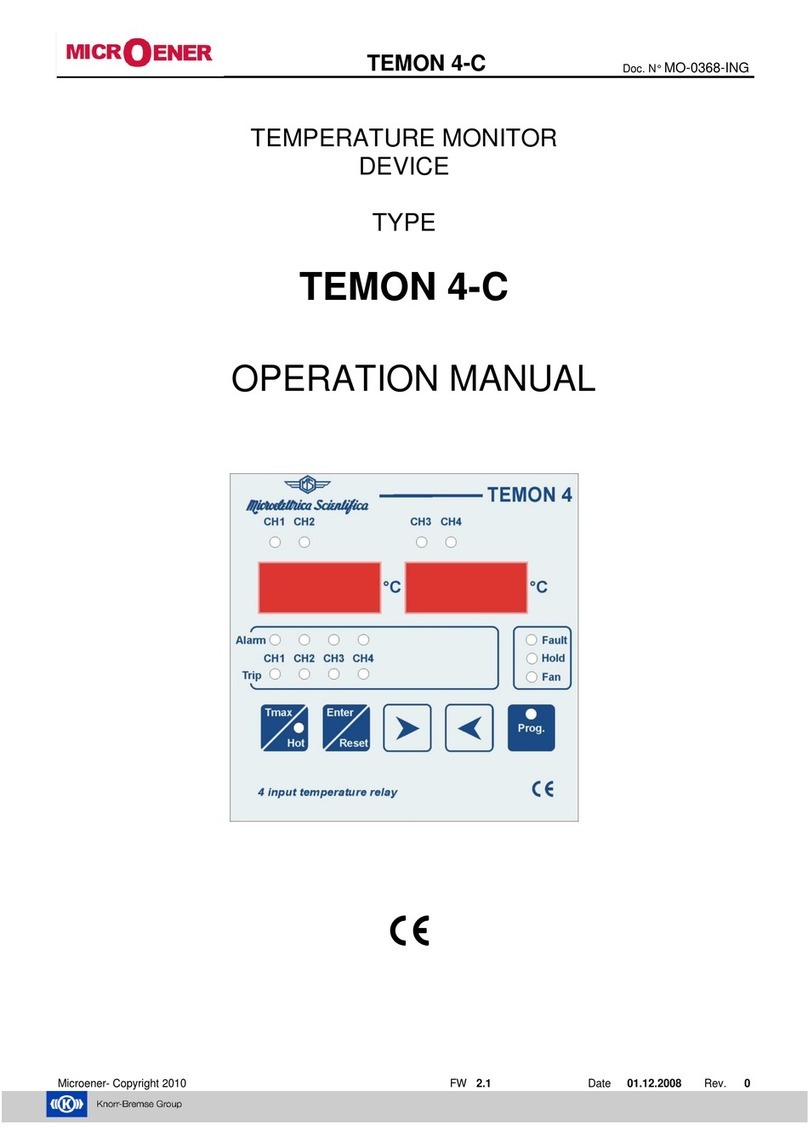
Knorr-Bremse
Knorr-Bremse MICROENER TEMON 4-C Operation manual
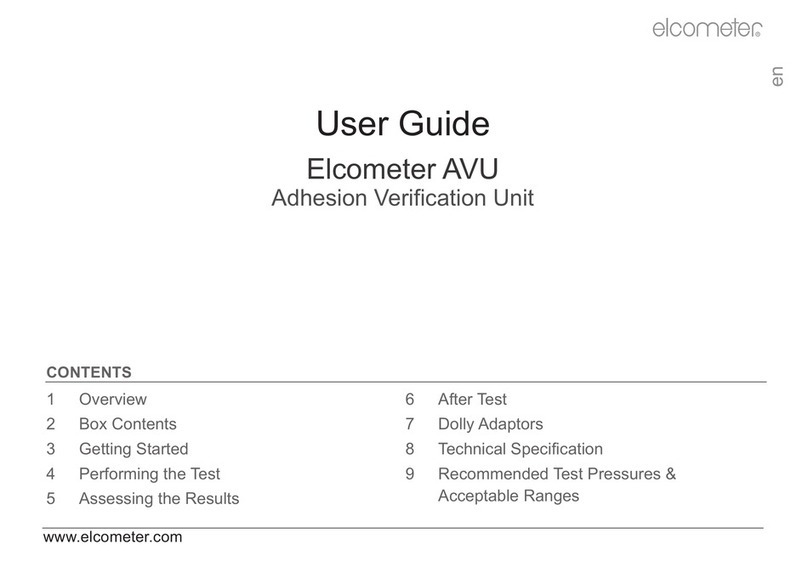
Elcometer
Elcometer AVU user guide
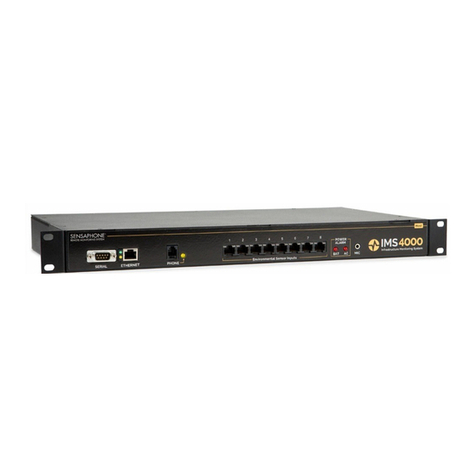
Sensaphone
Sensaphone IMS-4000 user manual
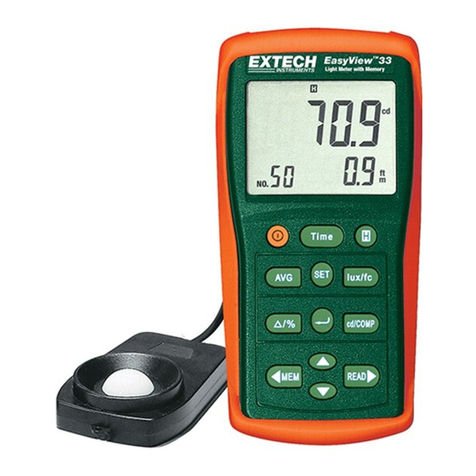
Extech Instruments
Extech Instruments EasyView EA33 user manual
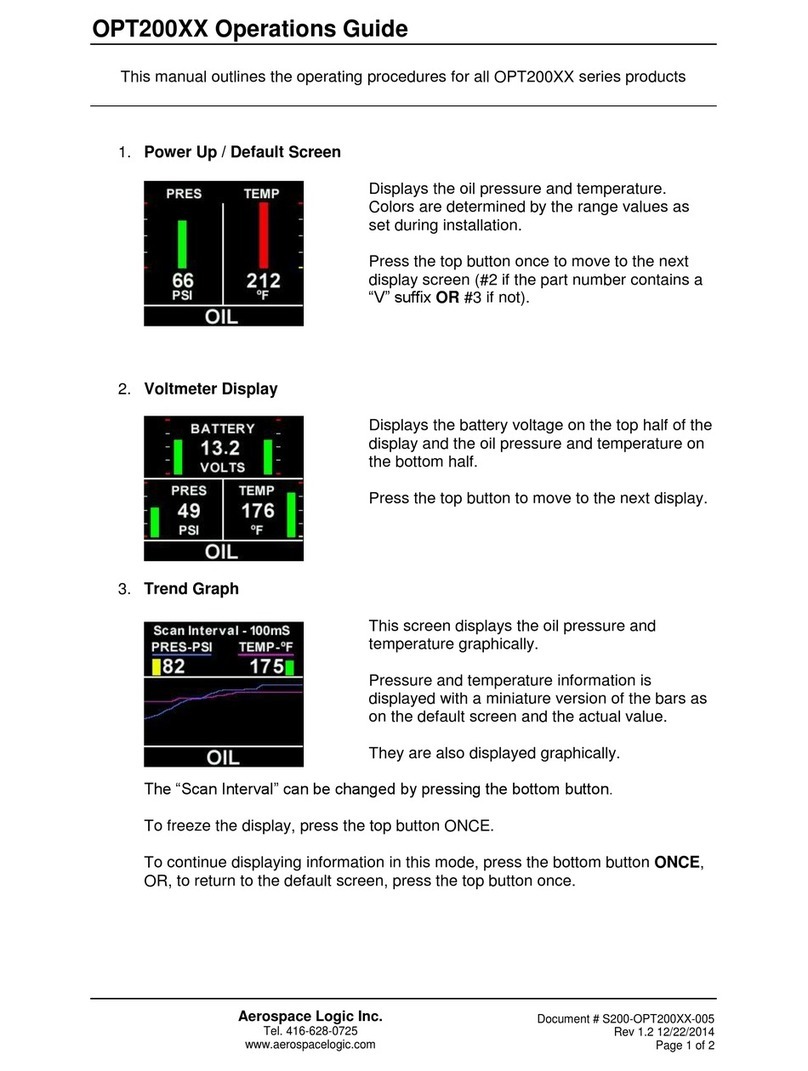
Aerospace Logic
Aerospace Logic OPT200XX Series Operation guide

